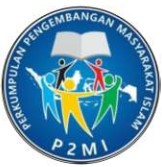Author Guidelines
Carefully read the submission guidelines as follows:
A. General Requirements
The minimum standard requirements of Jurnal Pemberdayaan Masyarakat must be:
- Manuscripts written in the Indonesian Language
- Writing at least 8 pages long and no more than 25 pages. Editors evaluate if the manuscript more than 25 page
- The use of a tool such as Zotero, Mendeley, EndNote or for reference management and formatting, and choose APA (American Psychological Association) Style.
- The paper begins with the manuscript title, author name, Author Affiliation, Address followed by an abstract written in italics (Italic) all 150-200 Words.
- If Indonesia language manuscript, then the abstract must be written in the language of Indonesia and English language of good and right. If the article United Kingdom, then the language abstract should be written in the language English.
- Manuscript with the Online Submission System at http://jurnal.uinsu.ac.id or portal (http://jurnal.uinsu.ac.id/index.php/PEMAS).
- Make sure that your paper is prepared using the Jurnal Pemberdayaan Masyarakat template.
- Notification of acceptance: within 30 (thirty) days after the date of the manuscript is sent.
Detail information download
DOWNLOAD GUIDELINES ARTICLE PEMMAS
DOWNLOAD TEMPLATE ARTICLE PEMMAS
B. Structure of The Manuscript
Introduction. The introduction should contain (structured) general background, the problem, previous literature review (state of art) as the basis of a statement of the scientific novelty of the article, a statement of scientific novelty, and the research problem or hypothesis. At the end of the introduction should be written the purpose of the article studies. In a scientific article, the format is not allowed for the review of the literature as well as in a research report, but expressed in the previous literature review (state of the art) to demonstrate the scientific novelty of the article and can be written development conceptually based on previous research studies.
Method. The method used to solve the problem is written in this section, Methods must be structured, clear and understandable as well as the right to use the method.
Results: Type the findings of scientific research in accordance with the method used. but must be supported by data and facts sufficient. No discussion on the results of research findings, this section describes only the findings of the research results.
Discussion: in this section is not re-write the research findings, but more scientifically reviewing the results of research, not restate data obtained research results. The scientific findings should be described in Science include: Do the scientific findings obtained? Why did it happen? Why such a variable trend? All these questions must be explained scientifically, not merely descriptive, must be supported by scientific phenomena. Furthermore, it should be explained also in comparison with the results of other researchers about the same topic. The results of the research and findings must be able to answer the research hypotheses in the introduction.
Conclusions: Each article closed with the conclusion that summarizes the answers of the hypothesis or research purposes or scientific findings obtained. Conclusions do not contain repetition of results and discussion, but rather to a summary of the findings as expected on purpose or hypothesis. If necessary, at the end of the conclusion can also write things that will be associated with the next idea of the study.
References. All references in the text of the article should be written in the References section. Reference should contain reference libraries derived from primary sources (journals). Scientific Journal of a minimum of 80% of the total bibliography) published last 5 years. Each article contains at least 15 (fifteen) reference was referenced. The format of writing used in the journal Scientific Management & Business is in accordance with the format APA 6th Edition (American Psychological Association).
Writing citations and references using automatic reference management to be more consistent in writing citations and references using reference management application program such as Mendeley, EndNote or Zotero, or other.
DOWNLOAD GUIDELINES MENDELEY
Examples of How Writing Bibliography by APA format 6th Edition (American Psychological Association)
Reference in the form of a Journal/magazine:
Islam, Md., Islam., Azim, A.Y., Anwar, Md. R. & Uddin, Md. M. (2014). Customer perceptions in buying decision towards Bangladeshi local apparel products. European Scientific Journal, 10(7), 482-497.
Reference in the form of book titles:
Schudy, C. (2010). Contextual Ambidexterity in Organizations: Antecedents and Performance Consequences (p.205). Switzerland: University of St. Gallen.
Rerefensi the form of translations:
Cresswell, J.W. 2008. Research Design: Qualitative, Quantitative, and Mixed Methods Approaches. Third Edition. Sage Publication. California. Terjemahan A. Fawaid. 2010. Research Design: Pendekatan Kualitatif, Kuantitatif, dan Mixed. Cetakan 1. Pustaka Pelajar. Yogyakarta
Reference in the form of Proceedings or conference:
Fitri, I. Juwono, dan A. Sabar. 2012. Zakah Perspectives as a Symbol of Individual and Social Piety: Developing Review of the Meadian Symbolic Interactionism. Global Conference on Business and Finance Proceedings 7(1). Februari 3-6. The Institute of Business and Finance Research: 721-742
bibliography in the form of Patents:
Hwang, H., (2010). Generalized structured component analysis with latent interactions. US Patent No, 5,576, 109.
Reference Publications Institution / Agency / Organization (Contains Association Rule of Law, and and its kind):
Badan Pusat Statistik. (2015). Laporan Bulanan Data Sosial Ekonomi. Januari. BPS Jawa Timur. Surabaya.
Kementerian Pendidikan dan Kebudayaan RI. (2010). Pendidikan Anti Korupsi untuk Perguruan Tinggi. Cetakan 1. Direktorat Jenderal Pendidikan Tinggi. Bagian Hukum Kepegawaian. Jakarta.
Ikatan Akuntan Indonesia (IAI). 2011. Aset Tidak Lancar yang Dimiliki untuk Dijual dan Operasi yang Dihentikan. Pernyataan Standar Akuntansi Keuangan No. 58 (Revisi 2009). DSAK-IAI. Jakarta.
Undang-Undang Republik Indonesia Nomor 20 Tahun 2003 Sistem Pendidikan Nasional. 8 Juli 2003. Lembaran Negara Republik Indonesia Tahun 2003 Nomor 4301. Jakarta.


